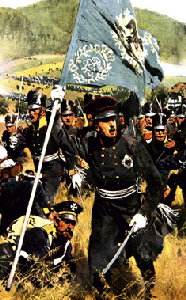 | | Left:
Prinz August leading the 2nd Silesian Regiment forward at the Battle of Kulm. | These pages appear thanks to a lot of reference material and advice supplied by Dallas Gavan in Australia - Cheers Mate.
The design and issue of flags and standards for the Prussian army of the Napoleonic wars falls into two distinct periods: pre 1806 and post 1806. Prior to the collapse of the Prussian army in 1806 the flags and standards carried by the Infantry regiments were virtually unchanged since the time of Frederick the Great. The Regiments each carried two flags per battalion. The first flag of the first battalion was the Leibfahne, the second a Regimentsfahne. The second battalion had two Regimentsfahnen. The three musketeer battalions and the two interim companies of the 60th regiment did not have flags at this time. In most cases the staff head was gilt (the Guard regiments had silver when they were raised but were later replaced with gilt). Staff heads were spear shaped and pierced with the royal monogram. Ribbons and tassels were silver with black stripes in all cases. Large numbers of flags were lost in 1806 and upon the rebuilding of the army many new flags had to be issued (1808 pattern). Those pre-1806 flags that survived were re-issued along with the new pattern. The 1807 instructions called for two flags per musketeer battalion, as previously issued, but no flags for fusiliers or grenadiers. Grenadier formations were carrying flags by 1812 but fusiliers (with the exception of the fusiliers of guard grenadier units who received flags in 1814) did not get flags until after the wars in 1815. The first flag of each battalion was known as the 'Avancierfahne' and the second the 'Retirierfahne' (thus the 'Avancierfahne' of the first battalion was also the Liebfahne). By 1813 only the 'Avancierfahne' of each battalion was carried, the returned 'Retirierfahnen' often being issued to new units as their 'Avancierfahne'; thus many flags for different regiments were identical. | |



